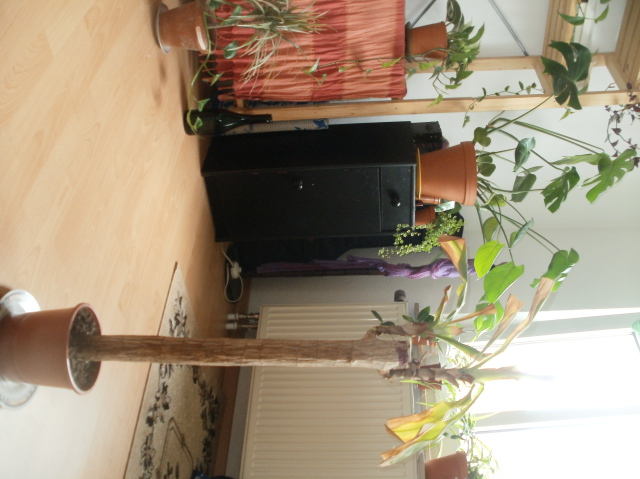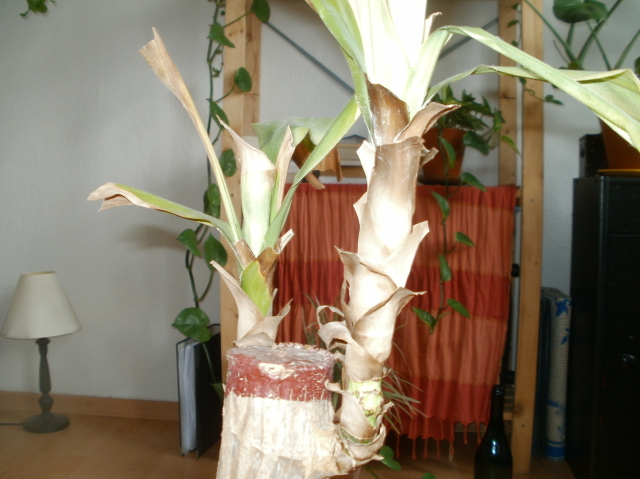Question
 full view
full view  close up
close up
Hi Will,
I have had this plant for over 18months now. It is one among the 31 other house plants I have. All the other plants I have, seem to have adjusted to their surroundings well except for this particular plant.
After I purchased this plant it threw out some new leaves pretty fast but soon after it slipped into a dormant phase. It maintained those lush green leaves and looked very healthy but just did not have new growth. Soon after this period, it has gone down and looks like this right now (please see pictures.)
I did a lot of Internet research and basically did only two things to protect this plant: changed the potting mix twice and changed its location.
I read that the plant has a very delicate root system hence I didn't want to put it through stress and just let it, hoping to see a recovery. I have never spotted bugs or any other kind of pests.
Could you have a look at the picture and tell me what is up with the plant and how I can save it (if at all possible).
Finally, I also have a dracaena marginata plant which I purchased around the same time as the one mentioned above. This one although has just not changed in any way. It looks exactly like the way it did 18 odd months ago. The plant looks healthy. The only thing growing on this plants are its roots. They got pretty intense and hence I re-potted the plant. It gets a lot of light like all the other plants in my room. I know that the plant is supposed to be slow growing but isn't 18months of dormancy weird?
Thanks very much Will and I look forward to your response,
Geetha
AnswerHi Geetha,
There are two things that will keep a plant from growing - not enough light and too much soil relative to the root system.
You haven't mentioned anything about the light your Corn Plant has received over the past 18 months, so I don't know if that is the primary problem. I do know from lots of experience that most people over-estimate the light they provide for plants. Your Corn Plant should have been right in front of an uncovered north window or within a few feet of any other uncovered window.
It is unusual for there to be only one cane (the thick, bark-covered trunk) alone tall in a pot. The nurseries almost universally put 3 or more canes of staggered heights into a pot that size. It makes me suspicious that there were two other canes that died before you acquired it. If that is the case, the roots may have already been damaged but the full effects had not yet become apparent. I am just speculating here.
In any case, the advice that you can "protect" a plant by changing the potting mix is wrong-headed. In the process of changing the soil, the tiny roothairs that you can barely see are invariably damaged as old soil is removed and replaced. These roothairs do most of the work and when damaged, the plant often declines. In addition, most potting mixes are not appropriate for certain plants, including the Corn Plant. So there is a very good possibility that the soil replacement that you did is a major contributor to the problem.
Improper watering may also be contributing to the problem. In inadequate light and in new soil after roothairs have been damaged, the plant will use very little water, but the new soil will retain water for a long time. The result is that it is very easy to keep the soil too wet for too long causing even further root damage and plant decline caused by root rot.
Your Corn Plant does not appear to be in good shape. If the bark has started to become loose and papery near the bottom of the cane, then the plant will not recover. Otherwise, remove all loose soil from the top that is not in direct contact with roots. This will help the soil in the root zone dry out a bit sooner. Do not water until the soil is dry at least a quarter of the way deep into the pot and then add only enough water so that it reaches that level of dryness again in a week or less. Of course, you must also be sure that your plant is getting enough light. At best, it will take a very long time for your plant to recover, so you will need to be patient and not try to do too much.
Your Dracaena marginata has been growing slowly because it is getting less than optimal light and/or because plants grow slowly until they are quite potbound. Indeed, the roots were growing and trying to fill the pot when you mistakenly decided to repot it. At best, that will cause the plant's growth to slow down as it tries to fill the pot with roots. At worst, the roots were damaged during the repotting or may now be rotting because of excess soil. I suggest you follow the same remedy I provided for the Corn Plant, except that the Marginata needs more light. It really should be located directly in front of your sunniest window.
The lesson to be learned here is that repotting or replacing soil almost never fix a plant problem but are the most common causes of plant failure.
I have written articles on repotting and on Corn Plant care that I will email for free to you (or anyone else) who emails a request to me at
[email protected].
Please let me know if any of this is unclear or if you have any additional questions.
If this information has been helpful, please click the Rate Volunteer bar below and enter a rating and nomination for me. I am a volunteer on this site so Ratings are the only compensation I receive for answering plant questions.
Need more information? Visit my website at:
A link to HorticulturalHelp.com
or email me at
[email protected] or call me at 917-887-8601 (EST)
Regards,
Will Creed, Interior Landscaper
Horticultural Help, NYC
Visit my website at: A link to HorticulturalHelp.com







